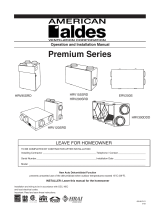INSTALLATION
GUIDE
TIPS
to installer
As mentioned in the section, the
Duotrol
TM
System has two different
purposes.
1. Mode Selector
2. Balancing Mode
The light indicator shows you in which
mode the Duotrol
TM
System is in.
GREEN LIGHT
Mode Selector
YELLOW LIGHT
Balancing Mode
Using the
Selector Switch
to installer
When on Balancing Mode, the Selector
Switch allows you to choose the motor
you want to set.
Closed Duotrol Cover
1. INTER (Exhaust Motor)
2. CONT (Both Motors)
3. OFF (Supply Motor)
or
Open Duotrol Cover
1. UP (Exhaust Motor)
2. MIDDLE (Both Motors)
3. DOWN (Supply Motor)
13. Balancing the unit
Step 1: Press the (+) and (–) buttons simultaneously until you
see the yellow light. Once the indicator light turns yellow you
are in balancing mode.
Step 2: When in balancing mode the selector switch becomes
the motor selector switch. INTER (Right Motor), CONT (Both
Motors) and OFF (Left Motor)
Step 3: Once the total cfm needed is determined, you can
start balancing the HRV/ERV. Set your fresh air supply by
selecting the “OFF” position on the Duotrol
TM
. Install your
magnehelic gauge and air flow grid in the fresh air duct.
Step 4: Press the (–) button to decrease the cfm or press the
(+) button to increase the CFM.
Step 5: Then perform the same operation on the stale air side
by selecting the “INTER” position on the Duotrol
TM
.
Step 6: The “CONT” position will allow you to adjust the cfm
on both motors proportionately (if necessary).
Step 7: Once this is completed, you have set the high speed
on your HRV/ERV. To lock balancing mode you must press (+)
and (–) buttons simultaneously and release. The indicator light
will turn green to indicate normal operation mode.
Step 8: Once high speed is set and locked, switch to
continuous on the Duotrol
TM
. By using (+) and (-) buttons set
low speed on the HRV/ERV.
Step 9: Select the mode of operation.
(Intermittent, Recirculation or Continuous Ventilation)
figure 13.1 Duotrol
TM
System
figure 13.2 Magnehelic Gauge with Air Flow Grid
figure 15.6 Selector Switch
figure 13.3 Magnehelic Gauge with Air Flow Grid
figure 13.4 Inserting Air flow grid in duct
figure 13.5 Seal Air flow grid in duct with duct tape.
14




















